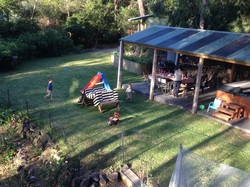This article engages teachers to reflect on learning through play.
In his seminal work, Play of Man, (click on the link to download a free copy) written in 1901, Karl Groos proposed that there are certain universal types of play which all children engage in and which help children to grow into fully functioning and effective human beings. Groos argued that whilst the exact form of the play is impacted by the culture around the child, the categories of play cross cultures. So, for example, whilst play-fighting occurs in all cultures playful sword-fighting only occurs in cultures familiar with swords.These categories of play are:
- Physical Play
- Language Play
- Exploratory Play
- Constructive Play
- Fantasy Play
- Social Play
 These types of play do not exist in isolation and as Peter Gray points out in his thought-provoking book Free to Learn, ”a lively outdoor group game may be physical play, language play, exploratory play, constructive play, fantasy play, and social play all at once.” Gray goes on to make a definition of what play is and defines it in five ways:
These types of play do not exist in isolation and as Peter Gray points out in his thought-provoking book Free to Learn, ”a lively outdoor group game may be physical play, language play, exploratory play, constructive play, fantasy play, and social play all at once.” Gray goes on to make a definition of what play is and defines it in five ways:
- Play is self chosen and self directed
- Play is an activity in which means are more valued than ends
- Play has structure or rules that are not dictated by physical necessity but emanate from the minds of players
- Play is imaginative
- Play involves an active alert, but non-stressed frame of mind
What leaps out to me about this list is that if we replaced the word play with learning virtually all educators I know would agree whole-heartedly that this was a wonderful list of what we seek to achieve in our classrooms.
Why is it then that so many schools are unable to build upon the natural playfulness of children and too often learning becomes:
- Entirely teacher directed
- Valued only as a means to achieve a grade or other external reward
- Has a structure and rules emanating from the minds of the teachers rather than the students
- Lacks imagination
- Involves passive students in a stressed frame of mind
I would not go as far as Gray does in his book in rejecting notions of traditional schooling, and would question whether the success he attributes to the alternative schooling system at Sudbury Valley, is not, in part, due to the Cultural Capital that the parents and students who go there possess. I do however feel that all educators need to look reflectively at how we can promote a playful state of mind in our students. Why is it that so many students and adults alike view learning not as play but as work? I would argue that often the reason we are unable to achieve this is that, whilst intellectually we may agree, on a core level many people do not accept Vygotsky‘s argument that “a child’s greatest achievements are possible in play, achievements that tomorrow will become her basic level of real action.”

Too often this lack of trust is obvious in the place where free play should be the most valued, the playground. In particular teachers concern about rough and tumble play where “the roughness of play is perceived by teachers and playground supervisors as potential problems. However, the potential benefits, such as conflict resolution training and motor skills training, are overlooked by many teachers.” (On the Child’s Right to Play Fight), means that even in the playground play is heavily regulated.
Once in the classroom, the time and space to play with objects and ideas is often limited or closely prescribed leaving students to feel that learning is something that is done to them not something they do. Do not get me wrong I am not arguing that teachers should not have a clear idea of where they will take student learning (see my previous post Four implications of structured inquiry). What I am arguing is that learning can be done most effectively if teachers have the confidence to give the students increased ownership over their learning and time to play with ideas without fear of the final product being ‘wrong’. In this way students will be empowered to go above and beyond the intended learning of the teacher and really reach their maximum level of achievement.
Whilst important things like high stakes external exams do place limitations on how far this can be achieved, hopefully the playful mindedness questions below will help you reflect upon this in your classroom, whatever age of student you teach. I would love to hear back from you whether they have enabled you to move learning in a more playful direction or whether you have other questions to provoke playful learning.
- How do I let my students know that I have confidence in them as self motivated learners?
- How much choice do your students have about how and what they learn?
- Is the learning space your classroom or the students classroom?
- How much input do students have in setting up the rules and norms of the classroom?
- Is there time and space for students to ‘play’ with objects or ideas?
- How is it clear that imagination and creativity is valued?
- Which word do I use most in class ‘play’ or ‘work’?
If we could all make our classrooms a little more playful I think we can move closer to having the happy motivated learners we all desire.
—
Derek began his teaching career at an inner city school in the UK. For the last 20 years he has been teaching in International Schools around the world. He began his involvement with the PYP when he moved to Milan, Italy in 2001. Derek is a PYP workshop leader and IB site visitor. He blogs at Thirst For Thinking.

